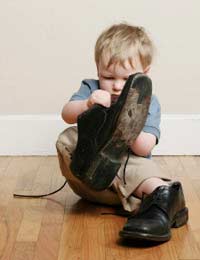How to Choose Children's Shoes

Unless your child complains that their shoes are hurting you may not be aware that your child needs new shoes. Periodically checking that shoes still fit properly, and that they are not worn in places or stressed at the seams, will help you identify if it is time for a trip to the shops.
When is the Best Time to Buy Shoes?
Because our feet generally swell throughout the course of the day, the best time to purchase shoes is late afternoon or early evening. Most children would rather be doing something else, than shopping for shoes, so ensuring that your child has a few distractions – particularly if they are very young – will also help make the experience more pleasurable.Children will outgrow shoes, rather than wear them out, so unless you are buying for a special occasion it is not worth buying expensive footwear.
How to Get the Right Fit
If you are fortunate enough to have a shoe store that specialises in children’s footwear this is the best place to go. Here trained sales assistants will not only be able to measure your child’s feet accurately, but they will also know the best way to get a reluctant child to try on different styles.Measuring your child’s feet will enable the sales assistant to find a shoe that fits perfectly around the heel and across the toes, with sufficient room for growth. Feet should be measured whilst the child is standing, and both feet should also be measured in case there is a difference in size.
Once your child is wearing the shoes, you have selected, make sure that their feet are extended fully. There should be about half an inch of space between the end of the child’s toes and the edge of the shoe toe.
Choosing the Best Style of Shoe
Children’s shoes should always have some kind of adjustable fastening – laces and Velcro are both excellent. It is best to avoid slip-on shoes or any style that is backless, as these do not offer an accurate and supportive fit. A patterned or textured sole is also a good idea, as this provides traction and helps prevent slips. To ensure the shoe is suitably sturdy you should check that the sole is thick enough to protect the foot from injury.Choosing a style that is made from a breathable material, like leather and canvas, will also allow your child’s feet to maintain the correct temperature throughout the day. Keeping feet dry and cool protects against blisters and maintains foot health and comfort. Leather and canvas are also hard-wearing and durable materials so the shoes you buy your child should perform well.
Best Avoided
Always avoid buying children’s shoes with heels. Although some styles may be particularly popular, shoes with heels will not only create problems in the natural development of your child’s foot, but they will also be uncomfortable for your child to wear and difficult to walk in. Sticking to shoes with flat and even soles provides the best form of foot protection.- Choosing the Perfect Wedding Shoes
- Choosing the Right Dance Shoes
- Where to Find Shoes in Larger Sizes
- The Benefits of Wearing Custom-made Shoes
- The Benefits of Barefoot Running
- Supportive Feet Products for Runners
- Supportive Feet Products for Senior Citizens
- What to Look For in Walking or Hiking Boots
- How to Buy the Right Training Shoes
- How Can High Heels Affect Your Feet?


Re: Footcare and the Housebound
My dad is housebound due to 5 major strokes. He walks with a walker and wears a foot splint. The splint is old, heavy and no longer…
Re: Supportive Feet Products for Senior Citizens
I have a prescription from Dr. at OHSU, but I need some lab to make the Orthodic insoles for my shoes. I was…
Re: How to Get into Foot Modelling
I am female 32yrs of age.I am from south africa I would like to enter into feet and hands modelling industry .I know and I…
Re: The Benefits of a Paraffin Wax Treatment
Hi! Does it cure sweaty palm and feet too?
Re: I have Sharp Pains in My Foot, What could it be?
Recently I have been experiencing a stabbing pain in my left foot,its on the bottom at the back. When I…
Re: Fungal Infections of the Foot and Toenail
I have a constant problem with intense itching on my feet which erupts daily, especially when my feet get warm…
Re: Cosmetic Foot Surgery
I have extremely sweaty feet and it seems to be getting worse. I have perspirex, but it doesnt help. Please help, I don't know what to do…
Re: The Benefits of Foot Massage for Children
One day I came home and my wife said our younger son was having trouble concentrating on his homework. I asked…
Re: Cavus Feet: Symptoms, Causes and Treatments
@sue - I am sorry to hear this. As suggested in the article, arch supports or orthotic devices may be used to…
Re: Cavus Feet: Symptoms, Causes and Treatments
My daughter has cavus feet and has had surgery a few times already. Her surgeon has dismissed her and she is…